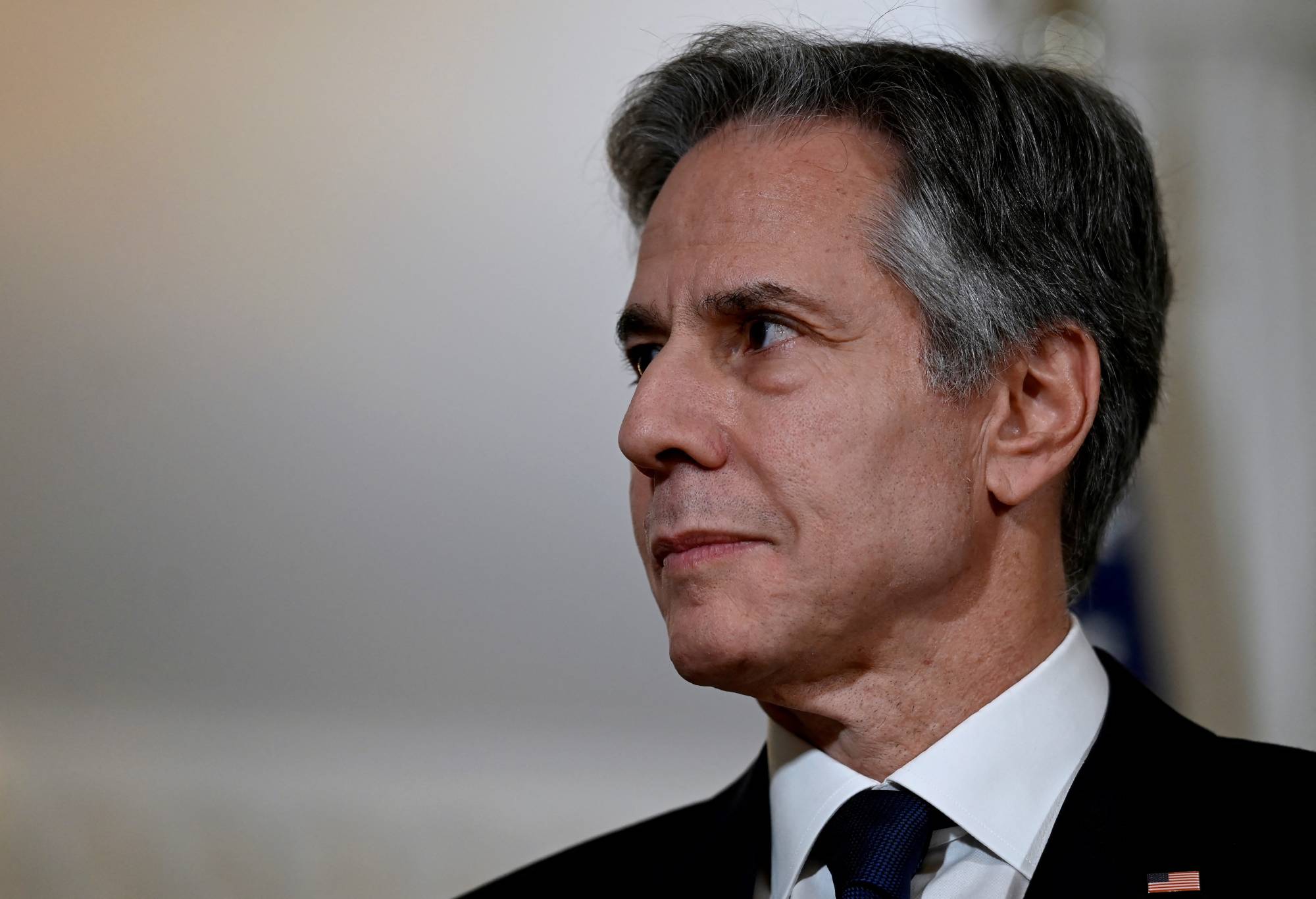U.S. hails Japan's new security strategy as China lashes out over moves

Prime Minister Fumio Kishida speaks at a news conference in Tokyo on Friday.
| POOL / VIA REUTERS
BY JESSE JOHNSON AND GABRIEL DOMINGUEZ
STAFF WRITERS
Dec 17, 2022
The U.S. has welcomed Japan’s “bold and historic step” to revise key security documents — laying the foundation for the country’s defense policies for years to come — while China slammed the move, sending an aircraft carrier-led flotilla through a key strategic waterway near Okinawa Prefecture in an apparent message to Tokyo.
The moves by the United States, Tokyo’s top ally, and China, which Japan has formally labeled as its “greatest strategic challenge ever,” came as Japan on Friday approved revisions to three key security documents, in a major shift in defense policy under its pacifist Constitution that signaled it is now more ready than ever to shed some of the postwar constraints on its military.
The revisions to the three security documents, which came after months of debate, will see Japan acquire a so-called counterstrike capability, which allows it to hit enemy bases and command-and-control nodes with longer-range standoff missiles. The country also set in stone a target of doubling its annual defense spending to about 2% of gross domestic product within five years.
“Japan has taken a bold and historic step to strengthen and defend the free and open Indo-Pacific with the adoption of its new National Security Strategy, National Defense Strategy and Defense Buildup Program,” U.S. national security adviser Jake Sullivan said, praising the defense spending hike, which he said “will also strengthen and modernize the U.S.-Japan alliance.”
U.S. Defense Secretary Lloyd Austin said the Pentagon backed Tokyo’s decision to acquire new capabilities “that strengthen regional deterrence,” including the counterstrike capability, adding that the updated documents reflected “important alignment” between the two allies’ vision and priorities outlined in their security strategies.
The documents referred to the U.S.-Japan alliance the “cornerstone” of Tokyo’s security policy, a stance echoed by U.S. Secretary of State Antony Blinken, who called Japan an “indispensable partner in addressing the most pressing challenges to global stability.”
BY JESSE JOHNSON AND GABRIEL DOMINGUEZ
STAFF WRITERS
Dec 17, 2022
The U.S. has welcomed Japan’s “bold and historic step” to revise key security documents — laying the foundation for the country’s defense policies for years to come — while China slammed the move, sending an aircraft carrier-led flotilla through a key strategic waterway near Okinawa Prefecture in an apparent message to Tokyo.
The moves by the United States, Tokyo’s top ally, and China, which Japan has formally labeled as its “greatest strategic challenge ever,” came as Japan on Friday approved revisions to three key security documents, in a major shift in defense policy under its pacifist Constitution that signaled it is now more ready than ever to shed some of the postwar constraints on its military.
The revisions to the three security documents, which came after months of debate, will see Japan acquire a so-called counterstrike capability, which allows it to hit enemy bases and command-and-control nodes with longer-range standoff missiles. The country also set in stone a target of doubling its annual defense spending to about 2% of gross domestic product within five years.
“Japan has taken a bold and historic step to strengthen and defend the free and open Indo-Pacific with the adoption of its new National Security Strategy, National Defense Strategy and Defense Buildup Program,” U.S. national security adviser Jake Sullivan said, praising the defense spending hike, which he said “will also strengthen and modernize the U.S.-Japan alliance.”
U.S. Defense Secretary Lloyd Austin said the Pentagon backed Tokyo’s decision to acquire new capabilities “that strengthen regional deterrence,” including the counterstrike capability, adding that the updated documents reflected “important alignment” between the two allies’ vision and priorities outlined in their security strategies.
The documents referred to the U.S.-Japan alliance the “cornerstone” of Tokyo’s security policy, a stance echoed by U.S. Secretary of State Antony Blinken, who called Japan an “indispensable partner in addressing the most pressing challenges to global stability.”
Antony Blinken | POOL / VIA REUTERS
“Our alliances and partnerships are our most important strategic asset, and Japan’s new documents reshape the ability of our alliance to promote peace and protect the rules-based order in the Indo-Pacific region and around the world,” Blinken said.
Japan’s revised strategic documents also revealed a tough new stance toward China as it continues to flex its military muscle near Japan’s southwestern islands, some of which lie as close as 120 kilometers from Taiwan, the self-ruled island that has become a potential flash point for Beijing, Washington and Tokyo.
“China has intensified coercive military activities around Taiwan, and concerns about peace and stability in the Taiwan Strait are rapidly increasing not only in the Indo-Pacific region, including in Japan, but also with the entire international community,” Japan’s new National Security Strategy said.
China has vowed to unify Taiwan with the mainland, by force if necessary. In recent years, Beijing has ramped up military pressure on the democratic island, including by conducting military training at a nearly nonstop clip nearby. This pressure culminated in August, when it lobbed five ballistic missiles inside Japan’s claimed exclusive economic zone near Okinawa Prefecture for the first time ever, during large-scale military drills.
China lashed out at Japan’s policy shift late Friday, with the Chinese Embassy in Tokyo decrying the move to characterize Beijing as an unprecedented challenge.
“Saying such things within the documents severely distorts the facts, violates the principles and spirit of the four China-Japan political documents, wantonly hypes the ‘China threat’ and provokes regional tension and confrontation,” a spokesperson of the Chinese Embassy said in a statement published by the state-run Global Times newspaper
“Our alliances and partnerships are our most important strategic asset, and Japan’s new documents reshape the ability of our alliance to promote peace and protect the rules-based order in the Indo-Pacific region and around the world,” Blinken said.
Japan’s revised strategic documents also revealed a tough new stance toward China as it continues to flex its military muscle near Japan’s southwestern islands, some of which lie as close as 120 kilometers from Taiwan, the self-ruled island that has become a potential flash point for Beijing, Washington and Tokyo.
“China has intensified coercive military activities around Taiwan, and concerns about peace and stability in the Taiwan Strait are rapidly increasing not only in the Indo-Pacific region, including in Japan, but also with the entire international community,” Japan’s new National Security Strategy said.
China has vowed to unify Taiwan with the mainland, by force if necessary. In recent years, Beijing has ramped up military pressure on the democratic island, including by conducting military training at a nearly nonstop clip nearby. This pressure culminated in August, when it lobbed five ballistic missiles inside Japan’s claimed exclusive economic zone near Okinawa Prefecture for the first time ever, during large-scale military drills.
China lashed out at Japan’s policy shift late Friday, with the Chinese Embassy in Tokyo decrying the move to characterize Beijing as an unprecedented challenge.
“Saying such things within the documents severely distorts the facts, violates the principles and spirit of the four China-Japan political documents, wantonly hypes the ‘China threat’ and provokes regional tension and confrontation,” a spokesperson of the Chinese Embassy said in a statement published by the state-run Global Times newspaper
China’s Liaoning aircraft carrier sails in the Pacific Ocean on Friday.
| DEFENSE MINISTRY JOINT STAFF / VIA KYODO
The criticism was part of an apparent two-pronged response out of Beijing, which also saw China send a six-ship flotilla led by its Liaoning aircraft carrier into the Pacific Ocean after transiting the Miyako Strait between Okinawa’s main island and Miyako Island.
The sailing by China’s carrier and five accompanying vessels, including two advanced guided-missile destroyers and a combat support ship, according to the Japanese Defense Ministry, was the first in the area since May. The flotilla was expected to conduct exercises in the Pacific Ocean.
Amid the closer cooperation with Washington — and Tokyo’s willingness to signal a harder line in its China policy despite an ice-breaking first meeting last month between Kishida and Chinese leader Xi Jinping — analysts say the moves are unlikely to lead to a further deterioration of ties with Beijing.
“What this does is to bring the language used in Japan’s security discourse in line with the rhetoric in Europe and the U.S.,” said Sebastian Maslow, an expert on Japanese security issues and a lecturer at Sendai Shirayuri Women’s College.
Still, perhaps one of the most striking aspects of the new security documents was Japan’s growing willingness to bring up the issue of Taiwan, long seen as a kind of taboo in Tokyo for fear of alienating Beijing, which views the fate of the democratic island as a core issue.
Although Tokyo has not changed its Taiwan policy or committed to helping defend the democratic island in the event of a conflict, experts view its repeated mentions in the revised security documents as an indication of support for Taipei.
“Japan considers Taiwan a key concern for its own national security,” said Maslow. “As such, the message is that Tokyo will be a stakeholder in whatever crisis might unfold and that it is willing to play its role in preserving the current status quo.”
The criticism was part of an apparent two-pronged response out of Beijing, which also saw China send a six-ship flotilla led by its Liaoning aircraft carrier into the Pacific Ocean after transiting the Miyako Strait between Okinawa’s main island and Miyako Island.
The sailing by China’s carrier and five accompanying vessels, including two advanced guided-missile destroyers and a combat support ship, according to the Japanese Defense Ministry, was the first in the area since May. The flotilla was expected to conduct exercises in the Pacific Ocean.
Amid the closer cooperation with Washington — and Tokyo’s willingness to signal a harder line in its China policy despite an ice-breaking first meeting last month between Kishida and Chinese leader Xi Jinping — analysts say the moves are unlikely to lead to a further deterioration of ties with Beijing.
“What this does is to bring the language used in Japan’s security discourse in line with the rhetoric in Europe and the U.S.,” said Sebastian Maslow, an expert on Japanese security issues and a lecturer at Sendai Shirayuri Women’s College.
Still, perhaps one of the most striking aspects of the new security documents was Japan’s growing willingness to bring up the issue of Taiwan, long seen as a kind of taboo in Tokyo for fear of alienating Beijing, which views the fate of the democratic island as a core issue.
Although Tokyo has not changed its Taiwan policy or committed to helping defend the democratic island in the event of a conflict, experts view its repeated mentions in the revised security documents as an indication of support for Taipei.
“Japan considers Taiwan a key concern for its own national security,” said Maslow. “As such, the message is that Tokyo will be a stakeholder in whatever crisis might unfold and that it is willing to play its role in preserving the current status quo.”


No comments:
Post a Comment